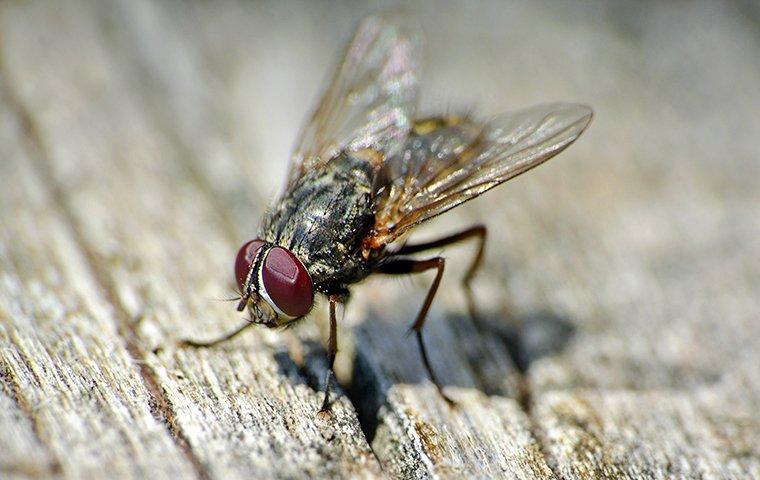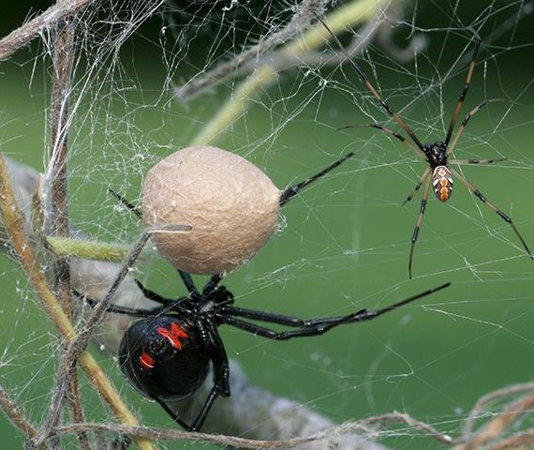Learn More About These Winged Invaders
Most people are no stranger to flies. This buzzing nuisance can turn any outdoor picnic or open kitchen into a nightmare. While most do not pose any serious health concerns to the humans or pets they pester, they are an annoyance that often requires professional help to completely eliminate from a home.
When it comes to flies, homes and businesses across the United States are typically affected by four main offenders: house flies, drain flies, cluster flies, and fruit flies.
House Flies
When most people think about flies, house flies are the insect that comes to mind. One of the most common flies found in homes across the nation, house flies measure about 1/4 inch long with grey coloration and four distinct black-colored vertical lines running across the tops of their bodies.
House flies constantly salivate as part of their feeding process, which involves liquefying solid foods using their acidic saliva because they cannot ingest solid foods. Because of this, house flies need water in order to survive. Therefore, they are commonly found in areas with prevalent water sources in the homes and buildings they infest.

Are House Flies Dangerous?
While they don’t bite humans, house flies can spread a number of diseases when they contaminate food with their saliva. House flies often land and feed on materials in garbage dumps, sewers, and animal excrement; any food items they land on afterward can be contaminated with whatever they landed on before.
Why Do I Have a House Fly Problem?
House flies often breed and feed on garbage cans or other debris around the perimeter of your home. If you have overflowing trash cans or other decaying matter outside your home, it could be inviting house flies to the area. Likewise, leaving doors or windows open without screens could attract flies to the smells inside, and from there lead them to your food.
How Do I Get Rid of House Flies?
Due to their small size and fast flight capabilities, house flies can be notoriously difficult to treat for most homeowners using DIY methods alone. If their constant buzzing around your home is starting to drive you insane, contact the professionals at Pestmaster® today to find out more about how our expert fly control methods can help you take back your home.
Drain Flies
Drain flies are a small fly species that grow from 1/5th to 1/16th of an inch in length as adults. They are gray to black in color with bodies covered in a coating of fuzzy hair. This hair makes them resemble some species of moth. They have large horizontal wings that only allow them to fly in short, frantic flight patterns; because of this, drain flies are very weak fliers compared to other fly species.
Drain flies derive their name from their tendency to congregate around drains, sewers, septic tanks, and other sources of water in homes and buildings they infest.

Are Drain Flies Dangerous?
Because they do not bite and are not known to transmit any human diseases, drain flies are not considered to be dangerous. However, they can become a huge nuisance around your home if not eliminated in a timely manner and can be a huge issue for kitchens in restaurants and other commercial food production facilities. Any extensive fly problem will damage a business's reputation.
Why Do I Have a Drain Fly Problem?
Drain flies are found living and breeding in moist organic debris. Sewers, basements, floor drains, and sink drains are all areas that collect organic debris and allow drain fly populations to flourish. To avoid attracting these pests, be sure to clean debris from your sink or floor drains regularly. If you have drain flies inside your home, they are likely flying around drains and resting on the bathroom, kitchen, and basement walls
How Do I Get Rid of Drain Flies?
While reducing areas of moisture and organic debris found in and around your home can go a long way in deterring them from coming into your home or business in the first place, eradicating an active drain fly infestation usually requires professional help.
If you have flies circling your drain, don’t wait! Take care of this annoying nuisance today with the help of the pest control professionals at Pestmaster®.
Cluster Flies
Cluster flies are a type of blowfly that appear similar to house flies. They are slightly larger than house flies and less metallic in appearance. Cluster flies are gray and grow as large as 3/8-1/2 inch long. They have black markings across their bodies and yellow hairs growing on their thoraxes and legs.
Cluster flies are parasitic organisms that feed on earthworms in order to survive. They are named for their tendency to cluster around windows once inside a home in an attempt to return outside.

Are Cluster Flies Dangerous?
Cluster flies don’t lay their eggs in human food like other species of flies. Instead, they lay their eggs near earthworm burrows. Because they don’t interact with garbage, sewage, droppings, and other unsavory elements the way other flies do, they are not considered dangerous. However, they are still a considerable nuisance to people and pets inside of the homes they infest.
Why Do I Have a Cluster Fly Problem?
Cluster flies need a warm environment to survive and are pushed into human residences in colder weather so that they can survive the winter months. Once inside, they tend to live inside attics, crawlspaces, and wall voids. When the weather starts to warm up again, cluster flies will emerge from their hiding spots to swarm around windows, light switches, ceiling fixtures, and door or window frames.
How Do I Get Rid of Cluster Flies?
Their small size gives them the capability to enter a building through the smallest openings. Once inside, they have a tendency to hide in hard-to-reach areas of the homes they infest. Cluster flies are very difficult to prevent and even more difficult to effectively treat once inside. If flies have started clustering around your windows or doors, don’t let them keep buzzing. Contact the professional fly pest control professionals at Pestmaster® for help and find out how our fly control methods can help keep these pervasive pests away.
Fruit Flies
Fruit flies are common pests found in homes, restaurants, and grocery stores across the United States. They are named for their tendency to lay their eggs in and feed on rotting or fermenting fruit. Fruit flies grow to about 1/8 inch long and are tan and black in coloration. Though small, they are distinguishable by their bright red eyes.
Fruit flies are a common test subject in genetic research due to their ability to breed quickly and lay many eggs. Unfortunately, their ability to reproduce quickly makes them an unwelcome nuisance when they infest your home.

Are Fruit Flies Dangerous?
For the most part, fruit flies are not dangerous. They are considered to be a nuisance pest. However, they do have the potential to contaminate food with bacteria and other disease-producing organisms.
Why Do I Have a Fruit Fly Problem?
Fruit flies are primarily drawn to homes with unsealed ripe or rotting fruits and vegetables. Bringing home fruits or vegetables that have had a previous infestation is the most common way that fruit flies enter homes. Adult fruit flies may also enter your home through open doors and windows that are not properly sealed or screened. For this reason, the best way to prevent fruit flies is to keep all fresh fruits and vegetables in your home refrigerated or stored in sealed containers.
How Do I Get Rid of Fruit Flies?
Fruit flies’ small size and aggressive tendencies make them a very difficult pest to treat for the average homeowner. If you’ve seen fruit flies buzzing around your kitchen, contact the professionals at Pestmaster® immediately. We’ll find the source of the infestation, eliminate it, and help keep your kitchen protected in the future.
For all your pest control needs, reach out to your local Pestmaster® team today!
.png)



